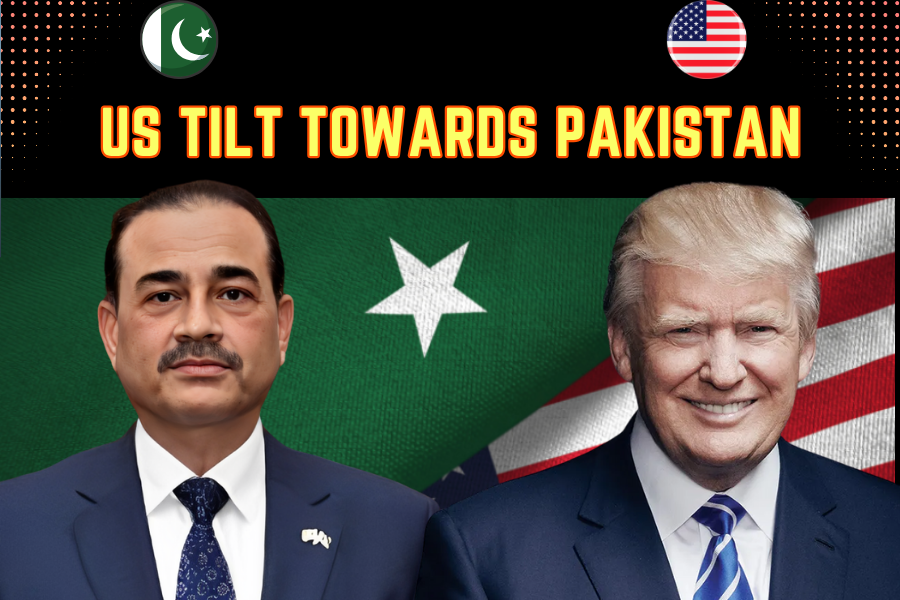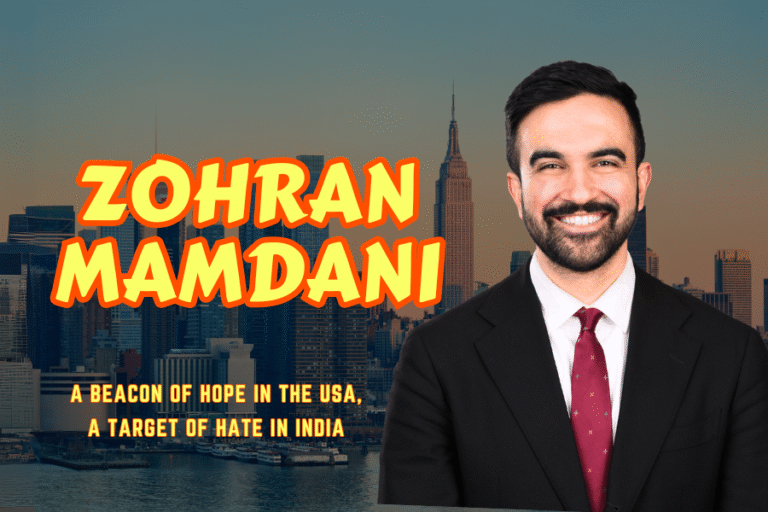(By Khalid Masood)
In June 2025, as US President Donald Trump lauded Pakistan as a “serious trade partner” and hosted its army chief, Field Marshal Asim Munir, for trade and security talks, a perceptible shift in US–Pakistan relations emerged, stirring curiosity and skepticism across South Asia. This tilt, marked by warm rhetoric from Trump and Commerce Secretary Howard Lutnick, who praised Pakistan’s “strategic potential” after a virtual meeting with Finance Minister Muhammad Aurangzeb, contrasts with decades of mistrust. From Pakistan’s perspective, this newfound amity is less about affection and more a calculated US maneuver to counter China, manage regional threats, and exploit economic opportunities. With Pakistan facing a $350 billion debt crisis and a 29% US tariff on its $5.61 billion exports, the stakes are high. This article delves into the real reasons behind the US’s tilt towards Pakistan, exploring counterterrorism imperatives, the China containment strategy, South Asian power dynamics, economic opportunism, and the fragile, transactional nature of this alignment, offering insights for Pakistan to navigate this delicate partnership.
I. Decoding the US’s Sudden Embrace
The US–Pakistan relationship, long defined by security cooperation and periodic sanctions, is undergoing a renaissance in 2025, driven by pragmatic necessity rather than genuine warmth. Trump’s effusive praise, calling Pakistan a “key ally” on Truth Social (25 June 2025), and the impending conclusion of trade talks signal a strategic pivot. Pakistan’s offer to import US crude oil and open its $6 trillion mineral sector, notably the $7 billion Reko Diq project, aims to mitigate a $3 billion trade surplus and punitive tariffs. Yet, this tilt is no love affair but a chess move in a complex geopolitical game, balancing counterterrorism, China’s regional dominance, and India’s drift toward Russia.
For Pakistan, a nation of 240 million grappling with economic fragility, this alignment offers a lifeline—trade relief, investment, and strategic relevance—but demands caution. The US’s history of conditional aid, evidenced by four sanctions since 2018, underscores the transactional nature of this bond. As per social media posts, “Trump’s Pakistan tilt is a tactical play, not a bromance.”
II. Counterterrorism and Security: Pakistan as a Linchpin
The US’s post-2021 Afghanistan withdrawal reliance on Pakistan for counterterrorism remains a cornerstone of this tilt. With ISIS-K, Tehrik-i-Taliban Pakistan (TTP), and Al-Qaeda remnants active along the Durand Line, Pakistan’s intelligence and airspace are indispensable.
- Intelligence and Access: Pakistan’s Inter-Services Intelligence (ISI) disrupted three major terrorist plots in 2024 sharing data with the US Central Command. Pakistan’s Ground Lines of Communication and airspace enable US over-the-horizon drone strikes, with 12 operations in 2024, per Jane’s Defence Weekly.
- Nuclear Stability: Pakistan’s 170 nuclear warheads, per SIPRI, are a US red line. Washington prioritizes securing Pakistan’s command-and-control systems to prevent proliferation, especially amid TTP’s resurgence, which attacked 18 military posts in 2024.
- Benefits for Pakistan: US counterterrorism aid, $1.5 billion in 2023, funds border security and drone surveillance, enhancing Pakistan’s 12,000-troop deployment in Khyber Pakhtunkhwa Province. Intelligence-sharing strengthens ISI’s capabilities against Baloch insurgents, backed by India.
Risks: US demands for Financial Action Task Force (FATF) compliance on terror financing could strain Pakistan’s autonomy, while over-reliance on aid risks domestic backlash.
III. Containing China: A Strategic Counterweight
China’s $62 billion China–Pakistan Economic Corridor (CPEC), a flagship of the Belt and Road Initiative, threatens US dominance in the Indo-Pacific, driving Washington’s engagement with Islamabad.
- CPEC Dilution: The US seeks to counter China’s monopoly over Pakistan’s infrastructure, particularly Gwadar port, a potential Chinese naval hub, per The Wall Street Journal. US investment in Pakistan’s $6 trillion mineral sector, including $500 million for Reko Diq, aims to rival CPEC’s $10 billion energy projects.
- Xinjiang Leverage: The US views Pakistan as a pressure point on China’s Uyghur policies. Engaging Islamabad ensures US intelligence access.
- Benefits for Pakistan: US financing diversifies Pakistan’s $26 billion foreign debt, reducing dependence on Chinese loans, which carry 4.5% interest rates, per the IMF. Access to US tech firms like Microsoft, with a $200 million investment in Pakistan’s IT sector, boosts economic autonomy.
- Risks: Aligning with the US could strain Sino–Pakistan ties, critical for CPEC’s $1.5 billion annual trade through Gwadar. Pakistan must balance both powers.
IV. Balancing South Asia: Offsetting India’s Russian Drift
India’s growing ties with Russia—60% of its arms imports and $5 billion in discounted oil deals in 2024, per Reuters—undermine US efforts to isolate Moscow, prompting Washington to bolster Pakistan as a counterbalance.
- India’s Unreliability: India’s refusal to join US sanctions on Russia and its abstention on Ukraine resolutions at the UN, per The Hindu, frustrate Washington. Pakistan’s neutrality on Ukraine, coupled with its May 2025 ceasefire with India, brokered by Trump, positions it as a reliable partner.
- Nuclear Risk Mitigation: India’s Cold Start doctrine, enabling rapid strikes, raises fears of nuclear escalation with Pakistan. Trump’s engagement with FM Munir, per Newsweek, aims to stabilize this dynamic, leveraging Pakistan’s nuclear arsenal to deter miscalculations.
- Benefits for Pakistan: US diplomatic support counters India’s regional dominance, particularly in the SCO, where Pakistan rallied Iran and Turkey against India’s espionage in 2025, per Press TV. Reduced tariffs could boost Pakistan’s $5.61 billion exports, per UN COMTRADE.
- Risks: The US–India $20 billion defence trade and Quad alliance remain priorities. Pakistan risks being a tactical pawn, as per social media , noting “India’s strategic value dwarfs Pakistan’s.”
V. Economic Opportunism: Tapping Pakistan’s Potential
Pakistan’s 240 million-strong market and strategic location offer the US economic opportunities, driving corporate lobbying and trade talks.
- Market Access: Pakistan’s $376 billion GDP (PPP) attracts US agribusiness (Cargill, Archer Daniels Midland), tech (Oracle, Amazon Web Services), and energy firms (ExxonMobil’s $100 million offshore drilling). A $3 billion US trade surplus in wheat and cotton, per USDA, underscores mutual benefits.
- Debt Leverage: Pakistan’s $10 billion debt to US-influenced IMF and World Bank gives Washington leverage to push austerity and anti-Russia votes, per Bloomberg. The US’s $215 million for Afghan refugee management in 2023 further ties aid to compliance.
- Benefits for Pakistan: US investment in minerals ($7 billion Reko Diq) and IT could create 200,000 jobs, per the Center for International Strategic Studies, easing Pakistan’s 16.5% poverty rate. Tariff relief would stabilize the rupee, down 20% in 2024, per State Bank of Pakistan.
- Risks: IMF conditions could spark unrest, as seen in 2023 protests, while over-dependence on US markets risks economic sovereignty.
VI. Regional Stability: Managing Iran and Refugees
Pakistan’s 900-km border with Iran and 1.3 million Afghan refugees make it a linchpin for US regional stability goals.
- Iran Monitoring: US intelligence uses Pakistani soil to track Iran’s missile tests, per The Media Line, especially after Iran’s June 2025 conflict with Israel. Pakistan’s neutrality in the Iran–Israel ceasefire, brokered by Trump, enhances its reliability.
- Refugee Crisis: US funding for refugee camps, $215 million in 2023, prevents spillover into Central Asia, aligning with Pakistan’s interest in border stability.
- Benefits for Pakistan: US aid strengthens border security, countering India-backed Baloch insurgents, per Dawn. Diplomatic support elevates Pakistan’s role in the OIC and UN.
- Risks: US pressure to monitor Iran could strain Pakistan–Iran ties, critical for $1.5 billion in oil imports, per Tasnim News.
VII. The Business Angle: Corporate Drivers
US corporations, eyeing Pakistan’s market and resources, lobby for closer ties:
- Defence: Lockheed Martin’s F-16 upgrades and General Atomics’ drone sales, worth $1.5 billion in 2023, drive Pentagon support, per SIPRI.
- Agriculture: Cargill and Archer Daniels Midland exploit Pakistan’s $3 billion wheat and cotton imports, per USDA.
- Tech: Microsoft’s $200 million investment and Oracle’s cloud expansion target Pakistan’s 70 million internet users, per PTA.
- Energy and Minerals: ExxonMobil’s drilling and Freeport-McMoRan’s interest in Reko Diq align with US strategic goals to secure critical minerals, per the 2025 NDAA.
These interests, amplified by the US Chamber of Commerce, push for tariff reductions and investment protections, per Reuters.
VIII. The Fragile Tilt: A Marriage of Convenience
The US’s tilt towards Pakistan is conditional, driven by risk mitigation rather than affinity. Pakistan’s compliance with FATF, neutrality on Ukraine, and counterterrorism cooperation are prerequisites for aid, per the US State Department. The trust deficit—evidenced by 2018 F-16 sanctions and Trump’s 2019 claim that Pakistan “harbored terrorists”—persists. India’s $20 billion defence trade and Quad role ensure it remains Washington’s priority, with Pakistan as a tactical hedge, per Foreign Policy.
For Pakistan, the benefits—trade relief, investment, and diplomatic clout—are tempered by risks of over-dependence and strained Sino–Iranian ties. As per social media posts, “US love for Pakistan is a mirage—trade today, sanctions tomorrow.” Pakistan must leverage this moment strategically, securing economic gains while preserving autonomy.
IX. Conclusion: Seizing Opportunity with Prudence
The US’s tilt towards Pakistan, heralded by Trump’s rhetoric and trade talks, is a pragmatic alignment driven by counterterrorism, China containment, South Asian balance, and economic opportunism. For Pakistan, it offers tariff relief, $7 billion in mineral investment, and defence cooperation, potentially creating 200,000 jobs and stabilizing its economy. Yet, this bond is fragile, a marriage of convenience shaped by US interests and Pakistan’s vulnerabilities. Islamabad must navigate this tilt with vigilance, balancing US engagement with CPEC commitments and countering India’s regional machinations. As Trump’s praise echoes, Pakistan stands at a crossroads—poised to harness economic and strategic gains, but wary of becoming a pawn in Washington’s game. History demands Pakistan act with clarity, securing its future with resolve and independence.








This is a timely and insightful analysis that thoughtfully unpacks the evolving dynamics of US-Pakistan relations in the context of broader regional shifts. The author does an excellent job highlighting how Washington’s approach is shaped not just by its China policy, but also by the complex realities of South Asia. I particularly appreciate the nuanced perspective on Pakistan’s strategic importance and the call for a balanced US engagement, rather than an over-alignment with India. The article is well-researched, objective, and provides much-needed clarity on issues often clouded by media bias. Kudos to the writer for presenting such a comprehensive and fair assessment—this is essential reading for anyone interested in geopolitics and South Asian affairs!